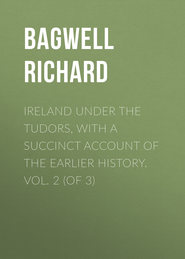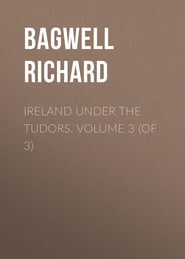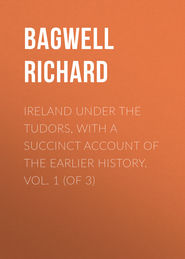По всем вопросам обращайтесь на: info@litportal.ru
(©) 2003-2024.
✖
Ireland under the Stuarts and during the Interregnum, Vol. I (of 3), 1603-1642
Настройки чтения
Размер шрифта
Высота строк
Поля
‘His Lordship was called into the House as a delinquent, and brought to the bar upon his knees, I sitting in my place covered’ – Cork’s Diary, November 11, 1640, in Lismore Papers, 1st series, v. 164; Rushworth, viii. 1-15, from November 6 to 30, 1640; Baillie’s Letters, i. 276, December 2; and 282, December 12, Strafford Letters; and November 5 in Whitaker’s Life of Radcliffe, p. 218.
262
Irish Lords Journal, February 18, 1640-41; Irish Commons Journal, November 7, 11, 12, 19, 1640, February 10, 1640-1. The Remonstrance is printed in the Journal and also in Rushworth, viii. Lords Justices and Council to Vane, February 13, 1640-1, in Cal. of State Papers, Ireland. On January 26, 1640-1, the Irish Commons voted 5,086l. for the expenses of the London Committee, which consisted of Sir Donough MacCarthy, Sir Hardress Waller, Sir Roebuck Lynch, Sir James Montgomery, John Walsh, N. Plunkett, N. Barnewall, Richard Fitzgerald, Simon Digby, Geoffrey Brown, and Edward Rowley.
263
Wandesford’s Book of Instructions to his son George, Cambridge, 1727. Autobiography of Mrs. Alice Thornton, Surtees Society, 1875. Wandesford’s letters have not been collected, but seventeen are printed in the Cal. of Ormonde MSS., Hist. MSS. Comm., 1902.
264
Strafford’s trial occupies Rushworth’s eighth volume. The report in Howell’s State Trials is founded upon A Brief and Perfect Relation of the answers and replies of Thomas Earl of Strafford, London, 1647. A third contemporary account is in Baillie’s Letters, i. 313-353. These three are the reports of eye-witnesses. The historian May was probably also present; his book was licensed May 7, 1647, and has some touches not found elsewhere. Nalson was an infant when Strafford died, and his account, which was published after Rushworth’s, has no independent value. Madame de Motteville (Mémoires, chap. ix.), reporting Henrietta Maria’s conversation, says Strafford ‘était laid, mais assez agréable de sa personne; et la Reine, me contant toutes ces choses, s’arrêta pour me dire qu’il avait les plus belles mains du monde.’ May says many thought of Ovid’s lines: ‘Non formosus erat, sed erat facundus Ulysses, et tamen æquoreas torsit amore deas’ – Earl of Cork’s Diary in Lismore Papers, v. 164, 170, 176. ‘The natural pity and consideration of women, sympathising with his afflictions, with sadness of his aspect, their facility with his complacences, their lenity with his pathetical oratory’ – Earl of Strafford characterised, 1641, Somers Tracts, iv. 231.
265
Lords’ Journals, May 6, 1641: ‘In equity Lord Strafford deserves to die’ as a subverter of fundamental laws – ‘Ingeniosissime nequam et in malo publico facundus,’ Falkland’s minute book in Lady Theresa Lewis’s Friends of Clarendon, i. 207.
266
Lords’ Journals, May 10, 1641. ‘The Primate of Ireland, who is no complimenter, reported afterwards to the King that he had then first learned to make supplications aright to Godward, and withal told his Majesty that he had seen many die, but never such a white soul (this was his own expression) return to his maker. At which words the King was pleased to turn himself about and offer a tear to his memory – tantorum mercede bonorum’ —Brief and Perfect Relation, p. 97.
267
Sir P. Warwick’s Memoirs, p. 110. Clarendon’s Hist. of the Rebellion, ii. 101; iii. 204. ‘A wise and promising face … yet a dark and promiscuous countenance, clouded, unlovely, and presaging an envious and cruel disposition,’ The Earl of Strafford Characterised, 1641, Somers Tracts, iv. 231; and the often printed lines ‘Here lies wise and valiant dust,’ etc., ib. 297. Strafford is at his best in the beautiful letter to Lady Clare, August 10, 1639, and in that to his son from the Tower, April 23, 1641, Strafford Letters, ii. 381, 416; and see his character by Radcliffe, ib. p. 433.
268
Alice Thornton’s Autobiography; Irish Lords Journals, February 22, 1640-1; Petition of the Irish Committee to the King, Cal. State Papers, Ireland, 1640, addendum; Radcliffe’s answer to the Committee, ib. January 9, 1641, and their rejoinder, ib. February 12.
269
Irish Commons Journals, February 16, 1640-1. The queries, with the answers and declaration of the Commons, are in Nalson, ii. 572-589.
270
Irish Commons Journals, 1641, p. 211; Irish Lords Journals, February 27, March 4.
271
Irish Commons Journals, June 7, July 10. The story about the powder is from Borlase’s Rebellion, ed. 1680, p. 12; he is not a very good authority, but on this occasion is speaking of his father’s action.
272
Examination of Henry Macartan, quartermaster to Owen Roe O’Neill, February 12, 1641-2, Contemp. Hist. i. 396; Vane to the Lords Justices, March 16, 1640-1, Cox’s Hibernia Anglicana, ii. 65; Cole to the Lords Justices, October 11, 1641, printed in Nalson and elsewhere; Lords Justices and Council to Vane, June 30, 1641, State Papers, Ireland; Deposition as to the Multifarnham meeting, May 3, 1642 (misprinted 1641), in Hickson’s Seventeenth Century, ii. 355. Temple produces evidence as to the rebellion being threatened long before it actually happened, O’More himself having admitted as much, p. 103. Patrick O’Bryan of Fermanagh swore on January 29, 1641-2 ‘that he heard Colonel Plunket say that he knew of this plot eight years ago, but within these three years hath been more fully acquainted with it’ —Somers Tracts, v. 586. Lieutenant Craven, who had been a prisoner with the Ulster Irish, was prepared to swear that on March 3, 1641-2, he had heard Bishop Heber Macmahon tell his friends that he had planned the rebellion years before, and knew from personal knowledge that all Catholic nations would help; urging them to persevere and extirpate heresy. Macmahon repeated this at Monaghan in January 1643-4 —Carte MSS. vol. lxiii. f. 132.
273
Lord Maguire’s Relation, written by him in the Tower (after August 1642) printed from the Carte Papers in Contemp. Hist. i. 501. Parsons to Vane, August 3, State Papers, Ireland. Temple’s History is valuable here, for he was present in Dublin and signed the proclamation on October 23, Bellings, i. 7-11.
274
O’Connolly’s Deposition, October 22, in Temple’s History, with the author’s remarks, and his further Relation printed from a manuscript in Trinity College in Contemp. Hist., i. 357.
275
Chiefly from Temple’s History, where O’Connolly’s evidence, and the proclamation of October 23, are given in full. There is an independent account by Alice Thornton, Wandesford’s daughter, who was in Dublin at the time, aged fifteen. According to her O’Connolly swam the Liffey. ‘What shall I do for my wife?’ he asked the conspirators, and they answered ‘Hang her, for she was but an English dog; he might get better of his own country.’ —Autobiography, Surtees Society, 1875.
276
Sir F. Willoughby’s narrative among the Trinity College MSS., 809-841, vol. xxxii. f. 178.
277
Temple, pp. 93-4. Macmahon’s Deposition, October 23, Contemp. Hist. i. Appx. xix. Lords Justices and Council to Leicester, October 25, printed in Temple’s History and elsewhere. Macmahon’s latter evidence, ‘taken at the rack’ on March 22, 1641-2, gives further details regarding the Ulster conspirators, but he knew nothing about the Pale, and does not even mention O’More’s name. Reports of Maguire’s trial have been often printed.
278
Proclamation of October 29, 1641, in Temple and elsewhere. Dean Jones’s ‘Relation of the beginning and proceedings of the rebellion in Cavan, &c.,’ was printed in London by order of the House of Commons in the spring of 1642, and reproduced in vol. v. of the Somers Tracts as well as in Gilbert’s Contemporary History, where the Cavan Remonstrance, received November 6, and the Lords Justices’ answer dated November 10, are also printed. Rosetti at Cologne heard that many Protestants had joined the rebels, which was certainly not true, though some pretended to do so. Roman Transcripts, R.O., December 10, 1641. Another paper from Cologne speaks of the rebels ‘quali vanno decapitando et appiccando li Protestanti che non gli vogliono assistere,’ ib. December 22.
279
Temple prints the commission to Gormanston as a specimen. Lords Justices and Council to Leicester, December 14, in Nalson, ii. 911.
280
Sir Henry Tichborne’s letter to his wife, printed with Temple’s History, Cork, 1766. Carte’s Ormonde, i. 193, and the King’s letters in vol. iii. Nos. 31 and 82.
281
Carte’s Ormonde, i. 192-5; Lords Justices to Ormonde, October 24, 1641, printed in Confederation and War, i. 227.
282
Bellings gives the two documents referred to. He was a member of this Parliament, and one of the Joint Committee. Irish Commons Journals.
283
Rushworth, iv. 398-406; Nicholas to the King, November 1, 1641, in Evelyn’s Correspondence; Macray’s edition of Clarendon’s History, i. 408; May’s Long Parliament, p. 127. May is a good authority for what happened in London, but for events in Ireland he depends chiefly on Temple. Lords Journals, November 1; Lang’s Hist. of Scotland, iii. 100; Vane to Nicholas, October 27, Nicholas Papers, i. 58.
284
Nalson, ii. 898; Rushworth, iv. 413; Diurnal Occurrences, December 20-25, 1641.
285
Despatch of December 14, in Nalson, ut sup. Monck’s letter from Chester, ib. 919, shows how little money Parliament had to spare. In clerical circles abroad it was rumoured a little later that Dublin would soon fall, and that five hundred Protestants who objected to the cross in baptism had been marked with it on the forehead and sent back to England —Roman Transcripts, R.O., February 2, 1642. Four letters from Sir Simon Harcourt, January 3, 1641-42 to March 21, in vol. i. of Harcourt Papers (private circulation). As late as September 16, 1642, Sir N. Loftus wrote from Dublin that the enfeebled garrison could not hold out for six weeks if seriously attacked. Food and ammunition were wanting, and the surviving soldiers sick or starving —Portland Papers, i. 700.
286








